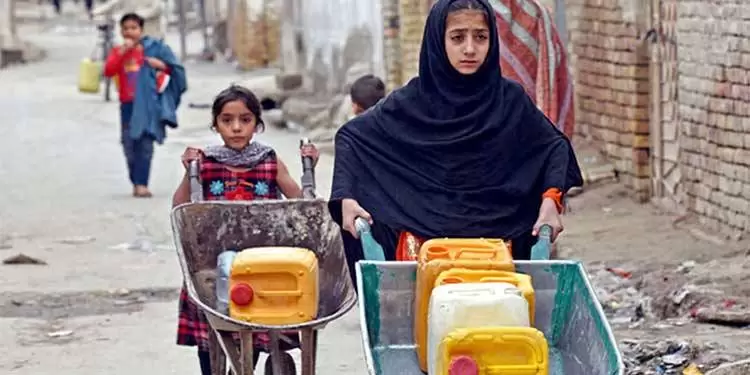
Twelve-year-old Gul Meena, a fifth-grade student from Mohmand district, says she struggles to complete her homework because fetching water is a daily burden. “As soon as I return from school, I have to go fetch water, which is far from home. By the time I return, I’m too exhausted to do my schoolwork,” she says, adding that she will likely drop out soon as she cannot manage both education and household responsibilities.
In all tribal districts of Khyber Pakhtunkhwa, fetching water is traditionally a woman’s responsibility, often requiring long and exhausting journeys.
A 2023 UNICEF report revealed that over 10 million people, including children in flood-affected areas of Pakistan, lack access to clean drinking water.
Shrinking Water Sources
Noor Bibi, a 75-year-old Mohmand resident, recalls when wells were brimming with water. “During the rainy season, I could easily draw water by hand, and even in normal days, wells were barely two to three yards deep,” she says. But now, she laments, either the wells have dried up or the water level has dropped significantly. Noor Bibi urges the government to take immediate action, emphasizing that worsening conditions force young girls to travel long distances for water.
Climate Change and Water Scarcity in Khyber
Mehrab Afridi, a senior journalist from Landi Kotal who has been covering water scarcity due to climate change for years, explains that the Khyber Agency never faced water shortages in the past. “Twenty years ago, there was no crisis—natural springs flowed, and water was easily available near homes. Women could fetch water without difficulty. But over the past 15 years, declining rainfall due to climate change has dried up wells and springs, making life extremely difficult,” he says.
Also Read: Lakki Marwat: Police Van Targeted in IED Blast, Terrorist Killed in Counterattack
Afridi highlights that in the past five years, over 20 tube wells in areas such as Pir Khel, Sheikhmal Khel, Sarah Ghbarga, Khyber Sultan Khel, and Mazrina have dried up, forcing women to trek through mountains and treacherous paths to access water.
Government Efforts and the Need for Action
According to documents from Khyber Pakhtunkhwa’s Environmental Protection Agency, the provincial government spent Rs. 6.7 billion on 13 drinking water projects last year to improve water access.
However, climate change experts warn that Pakistan’s water reserves are rapidly depleting due to changing weather patterns, floods, droughts, overuse, and wastage. Dr. Akmal Khan, former director of climate change in Khyber Pakhtunkhwa and chairman of the Agriculture Department at Peshawar University, stresses that climate shifts are reducing water availability.
Dr. Asif Khan, assistant professor of environmental science at Peshawar University, explains that climate change is altering rainfall cycles, worsening droughts, and directly impacting agriculture. “Factories are releasing increasing amounts of pollutants into the air, accelerating environmental degradation and further reducing rainfall,” he says.
Pakistan’s Battle with Extreme Weather
The Pakistan Meteorological Department and the National Disaster Management Authority report that the country has been facing extreme weather events for the past two decades, leading to rising casualties and damages each year.
The devastating 2022 floods claimed over 1,730 lives, submerged one-third of the country, and destroyed nearly 4 million acres of crops, affecting 33 million people. The estimated cost of recovery and reconstruction exceeded $16 billion.
The Urgent Need for Sustainable Water Management
The global trend of building large dams has declined due to rising costs, as noted by International Rivers, an organization advocating for river protection. Climate experts warn that Pakistan must take stringent measures to conserve water resources alongside constructing dams; otherwise, the country will face an even worse water crisis in the coming years.